A Dirt Road Excursion
I've decided that I will definitely be going to the Deerfield Dirt-Road Randonnée (D2R2) this year - a scenic ride along New England dirt roads that will take place in August. The 40 mile route is said to be tame in comparison to the longer options, but I still need to get used to riding on dirt roads if I am going to do it. So we began by exploring some of the ones close to our usual cycling routes: the Narrow Gauge Rail Trail that runs from Bedford to Billerica, and the Battle Road Trail that runs from Lexington to Concord. Both of these are pretty short (3 miles and 5 miles), but they are the only dirt roads I know of around here that aren't too technical. We incorporated them into our regular 40 mile ride, setting off on bikes with wide tires.
650B x 42mm Grand Bois Hetre tires on my Rivendell, and 700C x 50mm Schwalbe Fat Frank tires on his Surly. I know that some prefer to ride mountain bikes and be more upright on trails, but I really like the feeling of a roadish bike with dropbars on this terrain: My weight feels well-distributed and the speed and maneuverability seem to work in my favour when going either over or around tricky patches.
I am fairly certain that I would not enjoy a trail so technical as to require a dedicated mountain bike. Even this offshoot of the main path was too much.
When there are rocks and roots jutting out every which way, navigating around them is stressful - while going over them feels like riding a pogo stick. I don't think this kind of surface is for me.
But the surface of the main paths looked like this most of the time: Mainly packed dirt with some gravel, and occasional stretches of sand. These things I am more or less okay with.
We maintained a speed of about 12-13 mph most of the time on this surface, and I was fairly comfortable. When gravel is loose, it can feel like it's slipping out from under your tires - but the main thing is to get used to that sensation and just keep going. Easier said than done of course - especially when cycling down a winding incline. Even a gentle incline and a subtle turn can incite panic if it feels like your tire is slipping sideways. But braking is a bad idea and trying to put a foot down is a bad idea - pretty much just trusting in the bike's momentum and continuing seems to be the way to deal with this.
I did have a minor incident when we went over a stretch of deep sand. I was fine through most of it, but toward the end the mere awareness that I was cycling through sand just got too much and I lost my nerve. The bike started to topple and I sort of half-fell forward in slow motion (crotch onto toptube - ouch!), while desperately clutching the handlebars so that the bike itself wouldn't fall. Given that this hardly even qualifies as a fall, I am glad it happened: Now I understand how the bike behaves if I slow down in sand.
After this dirt road excursion, I am still not not sure how I feel about cycling off-road. Riding in the woods was nice and I do appreciate the fresh air and the quiet of being away from busy roads. But the slower speed felt limiting and I was very glad to be back on pavement and cycling at 20mph once we were done with the trails. The technical aspect - developing skills to transcend difficult terrain on a bicycle - is just not exciting to me at all in of itself. The aspect I do like is the feeling of exploring, and I hope to find some other trails that are longer and lead somewhere more interesting next time. What appeals to me about the D2R2 is the vastness and diversity of terrain it promises, with beautiful riverside views. It's a legendary ride, and I hope to be comfortable enough on dirt roads to complete it in August. Any advice for local routes to practice on most welcome!


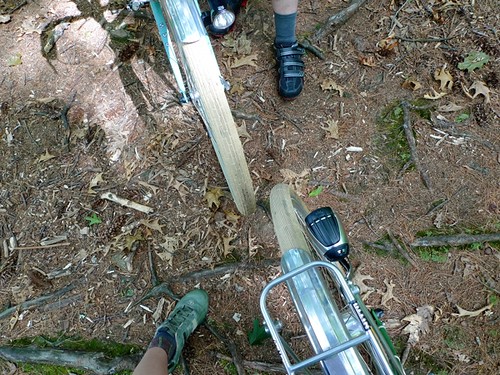
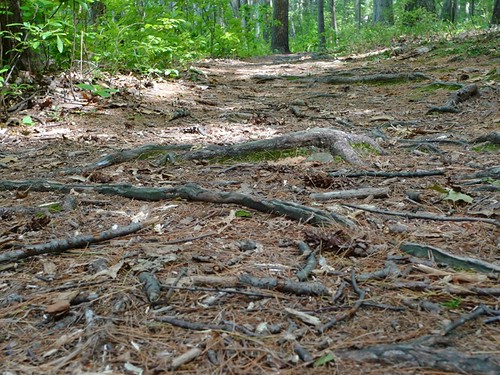
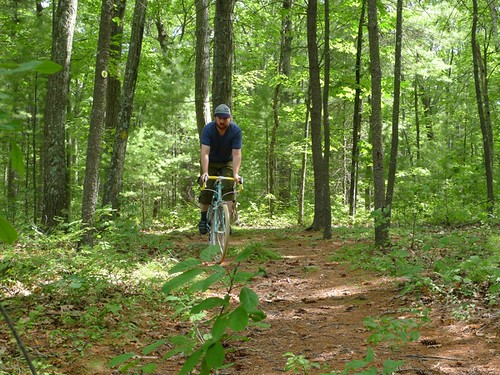
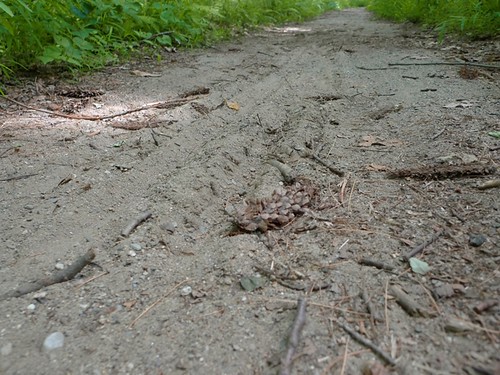
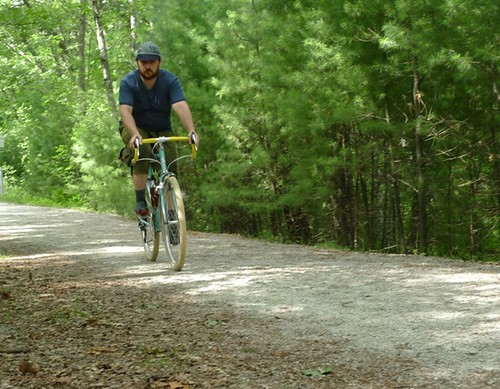
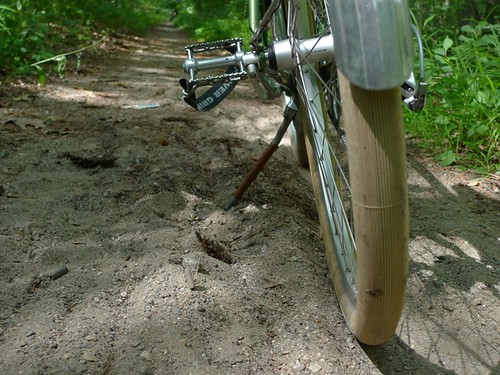
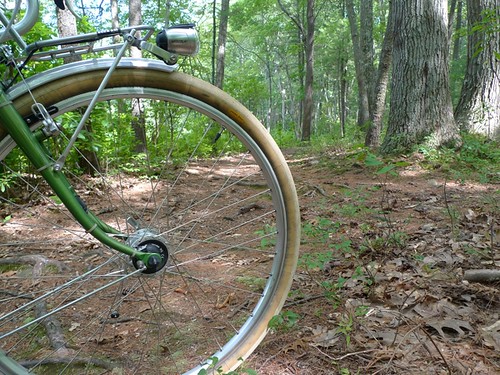
Braver than me, yet again! Bravo.
ReplyDeleteI had a good laugh today when one of the teenagers I was riding with showed up with brand new clip-in shoes she'd never really used before. She survived a flat tire and emergency stop just fine, then fell over when already stopped, when her shoe re-clipped itself as she leaned over. I immediately thought of you. She's got a few scratches from the chainring, but otherwise, she's fine. Keep on keepin' on with those dirt roads and clip-in shoes, V. If a 15 year-old can survive it, so can you :).
The top picture exemplifies my favorite type of riding. Nice hardpack dirt roads. Bummer that they're just not that fun for you.
ReplyDeleteIn case you didn't know it, be sure to keep your weight as far back as possible in sand and let your front tire just float through it while you spin the cranks as fast as you can. That's one of those non-exciting skills! :-)
speaking of local routes to practice, thought you'd enjoy this bit o' triumph: http://latimesblogs.latimes.com/lanow/2011/07/carmageddon-bicyclists-declare-victory-over-jetblue-flight.html
ReplyDeletecyclotourist - Wait, what?.. Do you mean, like try to make the bike "rear wheel drive"?
ReplyDeleteEven more so... rear-rear wheel drive! :-)
ReplyDeleteI know that you wrote this post for another reason altogether, but I have to say how wonderful it is that you and your sweetheart, the cohabitant, can cycle together. You are lucky. The pictures here, of that, togetherness spoke (heh!) much louder than your narrative of the trail.
ReplyDeleteLovely photos! I actually don't mind dirt or sand so much as pea gravel. Pea gravel was (seemingly) invented for the sole purpose of making you fall off your bike. And, given that my city is re-paving all of the roads, I've got blocks and blocks of it to contend with.
ReplyDeleteYou're right though, momentum is better than super slow cycling or braking constantly (which seems to make the bike fishtail horribly in gravel).
In any event, even if you don't decide to go with a longer, faster ride off-road, it may be something to consider for slow, upright scenic rides where you can take in the view. :)
Seeing your photos make me recall how much I enjoy riding off roas and how long it's been since I've done it.
ReplyDeleteThe only technical advice I can offer (and I know you weren't asking for advice) is to keep a supple but firm grip on the bars and use you arms and legs as shock absorbers. A 'death grip' on the bars never worked well for me. And sometimes, it is better to go a bit fast and float over obstacles like those tree roots in the second photo.
There are so many types of riding to try. I have been trying fixed gear for the first time this year and wasn't that thrilled with it the first several rides, but I've got to say that with practice I am starting to like it. I just hope my 50 plus year old knees can sustain this sort of riding.
1: stay loose
ReplyDelete2: keep your momentum
That's the only advice I can contribute to riding offroad. I love riding on the dirt; rocks, slippery wet roots, mud, everything except purpose built stunts really. On the other hand no force on earth could get me to ride in a paceline like you have done. That scares me! You can count me as one more cyclist that you're braver than in some ways.
We have a lot of little hard packed roads like that too here in the Groningen region. Not knowing that my first time out, I was quite unprepared for it and didn't really know what to do. I wound up walking through the sandy parts- it's awesome that you did so well!
ReplyDeleteThe other thing I've noticed here is that there will be a thin hard packed trail and the Dutch just come at you head on just like it's a normal bike path. I was so scared out of my wits that I swerved right too much and got into clumped grass. Not fun. Not sure I'll ever get used to riding so close to another person!!
Keep it up Velouria, you're doing awesome and I love your photographs :D
Congratulations on your dirt road ride. It looks like you picked a beautiful route; hope you find more like it. I agree with cyclotourist; keep up that momentum when riding through the loose stuff. I sort of like to think of it like a spinning top. When the top is spinning rapidly, it stays upright; but when it slows down it destabilizes and starts to topple over. I'm not sure if this is really a correct application of physics but it helps me understand the concept visually. Looking forward to hearing more about your dirt road ramblings on those beautiful bikes.
ReplyDeleteBe cautious - down this path lays cyclocross - and the mud pit!
ReplyDeleteCyclotourist got it right. You need to gear lower on dirt and gravel.
ReplyDeleteNow you're talking Velouria, with a little practice you will be able to maintain 20 mph on those trails, the adrealine blast is...a blast! I am a long way from you and so cannot suggest any local (to you) trails, but here are a few suggestions to make riding safer and more fun:
ReplyDeleteThe roots are best dealt with by lifting the bars just before your wheel hits them - you'll find that with practice the bike will just sail over them, plus ride "light" ie most weight on the saddle.
Not sure about drop bars, Something that keeps you fairly high in the saddle is good and you need constant access to the brakes and gear shifters, particularly when going fast.
The tires on your bike are OK when it's dry but for wet conditions you need lots of nobbles for grip, a compromise would be something like Schwalbe Hurricane Performance. Plus inflate to a 4-5 bar pressure. Suspension helps a lot on this sort of terrain, particularly front fork suspension.
Clipless (clip-in) pedals help a lot with these trails, loose surfaces may be powered across using a smoothly dosed (360 degree) power stoke to avoid spinning the wheels. Another use for clip-in pedals; adjust the clip tension so that you can jump the bike, useful for clearing roots and highly satisfying when you get the timing right, when you get it wrong...ouch!
Finally, safety gear, aside from a helmet (essential) I recommend always wearing eye protection and gloves to guard against springy branches.
Totally agree about the beauty of the trail; I often surprise deer and wild boar cycling around the in the Alps and Jura mountain forests, as a bike is so very quiet.
Lower the saddle. Giving up 1% or 2% or 3% of pedaling power is nothing. Speed and power is zero when you're lying on the ground. While you're still so uncertain the saddle should be low enough to quickly get a foot solidly on the ground at any time.
ReplyDeleteReduce tire pressure. Optimum pressure can be trial and error with pinch flats along the way. The extra control with lower pressure is worth it.
You're doing great. I'm not so sure about those tires, but I've never tried them. If I were you' I would try another set of tires, so that you could determine yourself whether it will make a difference. When I ride through sand, I keep the wheel straight and pedal through; works every time. Any jerky movement and I lose my balance.
ReplyDeleteNow, I know you're still not sure whether you like this type of riding, but if you ever get the chance to ride a full suspension bike over this type of terrain (and I'm not talking highly technical terrain), you will note a big difference in comfort, handling, and enjoyment.
"with a little practice you will be able to maintain 20 mph on those trails"
ReplyDeleteReally?? Unless it's downhill I can't imagine how; the bike just doesn't want to go any faster when the road surface is "sinky". It feels like walking on the beach.
You said it "the main thing is to get used to that sensation and just keep going" for some that feeling of slipping is too much and so they won't venture on gravel paths/roads which is too bad those roads can be fun and gorgeous. I like to think of gravel riding in two ways 1) its like a skills course -you have to pay attention to the road and how your bike is handling and 2) I pretend I am playing "Tokyo Drift" ;-)
ReplyDeleteR
This is great. Glad to hear that you'll be riding D2R2. Over the past few years I've been compiling an Eastern Mass dirt road map. It may be of some help. If you or other readers have any additions, let me know (my rule of thumb for additions, mostly comfortable riding it on a road bike with wide tires).
ReplyDeletehttp://maps.google.com/maps/ms?msid=206258317115966546442.00044ea594f66f66db59c&msa=0&ll=42.434733,-71.33234&spn=0.116685,0.252857
Brian - Thanks, what a good idea; I will have a look at the map!
ReplyDeleteBrian, thanks for that map! Will come in handy. Velouria, did you try the Reformatory branch? It starts a block from the end of the minuteman and ends right in Concord Center. It's lovely. I did it a few weeks ago, and it's not technical at all. There was one deep muddy section that forced me to turn back, but I'm sure it's dried up by now.
ReplyDeleteIt looks like it was interesting route, the thing to remember about 'Rough-Stuff' or 'off-road cycle touring' when you come to techical bit you can always get off and walk that bit!
ReplyDeleteAlso off-road cycle touring is about going to see what there and looking at the view!
I've liked riding on both of those trails (the narrow gauge rail trail and the battle trail). On Brian's map, the one mile stretch of Lincoln and Hazelbrook is quite pretty and I've used it from time to time as a quiet alternative to riding along 126.
ReplyDeleteI haven't done the 40 mile version of the D2R2, but comparing the 40 mile cue sheet against my past sheets for the 170k and 100k, it looks like it's mostly Green River Road, which is, in my recollection, fairly comparable to Battle Road Trail. Green River Road itself was pretty flat, so you shouldn't have to worry too much, about negotiating some of the steep climbs or bouncy descents that D2R2 is known for.
Was the co-habitant going to be doing the 40 mile version with you or was he planning on doing one of the other route options?
Have fun!
I know I'm not saying anything that hasn't already been said, but you won't get the maximum possible enjoyment out of riding off road unless you have the most appropriate equipment and some skills -- in exactly the same way that you were not enamored of paceline riding until you had the right bike and enough experience to know what you were doing.
ReplyDeleteFor the terrain that I see in some of your photos, you will do much better on wide (50+) tires with tread. The Hetres just aren't up to the job. Don't inflate the tires to anywhere near max pressure. Lower pressure will give you better traction and smooth out the ride. I'm not saying that you can't use drop bars, and I know you like them, but, again, they're far from ideal for riding off road. In the first place, as others have noted, when riding off road, you need to be able to unload your front wheel, so you need your weight to be distributed more to the rear of the bike than you would if you were on the road. Higher bars will help with this. Mountain bars and even North Road bars are also generally wider than drop bars, and for many people the greater width allows greater control. Sure, it's less aerodynamic, but that's not what off-road cycling is about. I'd also recommend a frame with a top tube that is slanted to a greater degree than your Sam. That will reduce your standover, and allow you to put your feet on the ground, if things start to go awry, without having to worry about the top tube slamming into places you'd rather it didn't. Finally -- and this is something with which I am sure others will disagree -- I would not personally ride clipless pedals on anything very rough or slippery. It's too easy to forget to unclip when things go wrong. I'd ride platform pedals with studs (and maybe Power Grips). The studs can rip up your shins if you aren't careful, but they grip well and the platform pedals enable you to dismount quickly when you need to do so. You can also move around on them as necessary. Depending on the terrain, off-road riding may require one to change direction, speed, body position, and so forth to a much greater extent than road riding does (at least in my experience).
I'm not saying that you need to like riding off road. Lots of people don't. But I don't think you can know whether or not you like it unless you give it a fair chance. And this requires the proper equipment, plus some experience in order to become more skilled. I suppose that lending you a high-quality mountain bike might be considered riskier than lending you a high-quality road bike. :-) Still, I'm guessing that if you could borrow a Seven you could find somebody to lend you a top-shelf MTB. If so, maybe you'd give it a try?
Sorry about the lecture. I'll climb down off my soapbox now . . . And I'm really happy to see that you're going to do the D2R2. I wish I lived closer to it and had the time. Sounds like a lot of fun.
somervillain - I am going to try the Reformatory branch next. I've heard there are felled trees and other obstacles all over it, but it seems that maybe they've cleared those up?
ReplyDeletecris - He is not going; just me.
Steve R - Mountain bikes are actually not recommended for the D2R2, few participants use them. Road/touring bikes with wide tires are what's suggested as far as I understand, and I am told the Rivendell is just about perfect for that kind of riding.
ReplyDeleteThe local trails in my pictures must look worse than they are, because it is very popular here to ride them on non-mountain bikes - just road bikes with 32mm tires or wider.
I am not saying that there aren't instances where mountain bikes do the job better - only that I don't think that's the case here. I know over a dozen people personally who will be riding the D2R2, and none of them will be riding a mountain bike.
I personally prefer a Mtn bike for trails like that, but that's why they make both kinds of bikes. Lots of good advice given already (easy grip, slightly lower tire pressure, "float" over bumps, etc.), but here's one more item.
ReplyDeleteDo not, do NOT "keep your eye on the ball"! If you stare at the trail directly in front of you, you WILL hit/run over the obstacle you are looking at. I know it sounds a bit counter-intuitive, but look just a bit further ahead, say maybe 1 or 2 bike lengths. With a bit of practice, you will be able to navigate around those things that give you fits on the trail.
Once you gain these skills, you'll be amazed how much better your road handling skills become, especially on poorly paved roads.
Oh, and use PowerGrips or toe clips if you're not 100% comfortable with clipless. Keep them a little looser than when on the road. They'll hold your feet on the pedals when the trail is rough, but are much easier to get out of in a hurry.
Have fun!
Mary Kaminski
Philly, PA
Not trying to be argumentative, but genuinely curious and confused: What sort of riding are touring bikes with 42mm tires designed for, if not mixed on/off road, whereby the latter is mostly fire trails and carriage roads?.. Certainly not for pure roadcycling. I understand why you'd want a mountain bike for narrow technical trails, but not why it's a good idea for mixed pavement/dirt terrain. Would appreciate it if anyone cares to clarify.
ReplyDeleteAround here mixed terrain equipment varies according to route picked. It's not unusual to see a 50/50 mix btw road/cross and mtb bikes of hardtail and full squish varieties. It's a personal comfort level choice.
ReplyDeleteAll things being equal the mtb is more comfy but at an efficiency cost due to the tires one usually runs on one. This is true regardless of terrain; they make great city bikes too for the right rider.
If no one in your group is running mtb presumably at least a few of them know what they're getting into. A little tread on the tires don't hurt traction, but ask around regarding tire pressure in your group. If you're getting bounced around a lot it says your pressure is too high, but I don't know anything about Hetres' durability so caveat here.
Lower pressures mean also you go slower, but see more too.
Velouria -- a MTB may not be the best for the D2R2; I'm in no position to judge, since I'm unfamiliar with the route. But if you're going to be riding -- not necessarily on the D2R2 -- in mud, sand, loose gravel, tree roots, etc., you will almost certainly fare better with wider, well-treaded tires, a different sort of handlebar, and maybe certain other mountain bike-y sorts of things. I hope you won't be offended, but I can't quite understand what comes across (perhaps only to me) as resistance to giving some of them a try. It seems contrary to the adventurousness and penchant for experimentation that one sees revealed so consistently in your wonderful blog.
ReplyDeleteNote to self: Relax, have a drink, and stop being so argumentative.
An all-road bike with relaxed road geometry, drop bars, wide supple knob-less tires and a sprung saddle have been used by many on such unpaved roads from the 90's to the 00's, 10's, 20's, etc. all the way to the present century. MTBs have definitely expanded the range of bicycling, but these roads aren't new to bikes.
ReplyDeleteI'm sure may prefer MTBs on such roads, but I don't since even on unpaved roads, I find the roads Veloria is riding here are more smoothish overall and the sand trap, mud hole, tree root, etc are an occasional not a persistent annoyance. All-road bikes are great here because they handle the whole road from pavement to dirt to gravel to roots splendidly, though not perfectly (MTBs, esp with knobby tires, are decidedly not perfect on the 10-15 mile paved ride to get to our dirt roads).
I agree with most of the skill comments, though I'm happy to go slowly or walk rather than to rely upon skill perfection.
Steve R - You're not coming across as argumentative. I guess my penchant for experimentation is not random, but applies only to the type of cycling that attracts me.
ReplyDeleteAlso, I probably haven't made it clear enough that I've owned and ridden mountain bikes. Last time I rode one was just over a year ago.
There are two aspects to the whole MTB experience that I do not especially like: One is the bikes themselves. Maybe it's just me, or I haven't tried mountain bikes that were "nice" enough, but I have found them to be unwieldy and slow; I do not enjoy riding them in comparison to the bikes I now own. The other aspect that does not appeal to me is the sort of terrain that actually requires full on mountain bikes: That picture of roots in this post was an example of the kind of path I *don't* want to cycle on.
I have no logical explanation as to why a certain type of bike or terrain does not appeal to me whereas another does, except that preferences are inherently subjective. We can only write about what interests us, after all - or else it will all start to seem like a chore.
Mtbs are relatively slow, for sure. They're kind of masculine too.
ReplyDeleteAnyway, you have enough bike for the ride. Once you do it your perception of what equipment is needed might change or not. No need to get a special machine now or even think of one.
You have the speed gene, evidently.
oh, I thought the Co-Habitant had acquired the Surly with the D2R2 in mind, no worries.
ReplyDeleteI'm of a couple of minds about MTBs on the D2R2. On one hand, having a MTB with suspension and wider wheels will certainly be useful for certain stretches of the ride (keeping stability on the rougher descents, maintaining traction on some of the steeper climbs) but, overall, they will be slower on the flats, pavement and the less steep climbs. Friends of mine who've done the D2R2 on mountain bikes have usually missed their road bikes about halfway through, but if you don't mind trading some speed for control, they're worth considering on the hillier bits.
However, mountain bikes aren't needed for the River Road. The Middlesex Fells? The Blue Hills? sure, take a mountain bike for that. River Road's too flat and smooth to make it worthwhile.
off topic, but can you tell me what size honjos you're running with those hetres? thanks!
ReplyDeletedavid - They are Velo Orange Zeppelin fenders for 650B.
ReplyDeletecris - He did acquire the Surly with that sort of thing in mind initially... he is a complicated man : )
GR Jim - speaking of running lower pressure, my legs are killing me the next day and I'm pretty sure it's from that. I've never cycled with these tires this low before!
That's stress for ya. Just adapt and try not to kill it like a road bike. Ease into each stroke, feel it. Don't mash it, use lower gears than you'd think.
ReplyDeleteIt's a rhythm you have to adapt to.
You'll be stronger upper body than with pure road.
Rake & trail, much discussed on this blog, go out the window when offroad. Impossible to calculate trail because the contact patch for the front tire is not a predictable location. The contact patch is continuously changing. The bike's handling is continuously changing.
ReplyDeleteIt's up to the rider to make the bike handle offroad. The rider must be loose, supple, and apply lots of body english. Offroad riding requires the cyclist to be very active on the bike. Steering stability is not on autopilot, it's all up to the cyclist. Arms and legs are shock absorbers and they take a beating.
The further back you can sit, and the less weight on the front wheel, the more stability you'll have. The front wheel should be light and allowed to float.The saddle needs to be low just so it will be out of the way. At the extreme, trials riders use those vestigial saddles that sit an inch off the back tire,right above the rear axle.
Racing bikes of the '20s, '30s, '40s, '50s are well set up for rough roads. The riding postures of that era work well too. Those guys managed to cope with awful roads all day long, sitting down.
I don't like my previous comment.
ReplyDeleteYour body will adapt and it'll serve you well on the road.
V, sounds like you dislike off-road for the most part because you don't want to fall, and the road surface feels more slippery. Even if the chance of damage is much higher at high speed on a smooth paved road, you *feel* more in control there. Perception is always interesting. I find the Raleigh Sports does just fine on tightly-packed "soft surface," which is the local authority's euphemism for non-paved roads. That said, I was terrified for a great deal of the mile or so I rode on such a surface recently, though the bike was fine. It was all about my perception of what I was doing. Yet I ride on icy paved trails in the winter with far less fear, even though I know I could slip (and probably will) there too.
ReplyDeleteJust a note about MTBs
ReplyDeleteThese are simply bikes that evolved after your compatriots realized the fun to be had riding old bikes in the mountain terrain around Marin County. The early pioneers went on to found the Specialized and Marin bike companies, plus others I am sure.
Initially the only difference was that the frames were reinforced to stop them falling apart with the high impact loads placed upon them by the harsh terrain. All other components (eg sturdy 26" wheels, big chunky tires) were chosen for suitability to the trails.
These days a MTB frame tends to have the bottom bracket higher for clearance but then it's just a question of whether one wants full suspension or a hard tail. I'd say that if you have a weak back or simply prefer a comfortable ride then go the full suspension route. For many off road tracks, front suspension is a great aid to stability, hence comfort and safety although suspension comes with higher purchase cost, higher weight and continued maintenance cost (revision every 2 years under regular use). If you do want to go bombing down rocky trails at anything up to 45 mph then you should choose a very stiff and heavier framed MTB for security, (very scary on a light flexible one).
Hence for riding the trails under discussion you certainly don't need a MTB frame per se, but the comments about riding position and tires are relevant.
Other than that it's all down to comfort. I've actually ridden trails such as you describe on a rather heavy dutch style city-bike, great fun, and fortunately the surface was baked dry. However the riding position was good, although not a recipe for 20 mph progress though. That requires something a little more specialized :-)as well as a love of speed.
Just some calibration for you.
ReplyDeleteI’ve done numerous loaded touring in Australia and that has included a fair bit of dirt back road. These tend not to be well maintained – they are rutted, pot holed and there are sections of sand, rock or gravel. No tree roots though!
This has been on a touring bicycle with drop bars. I’ve managed OK on 32mm tires with some slipping and 35mm tires seems to give a perfectly acceptable ride.
Tony
V, when I rode teh Reformatory Branch, there were no fallen trees. IT was smooth sailing for about half the length... the only obstacle being mud, as I mentioned earlier. It was too deep for the Hetres-- about 2" deep, and the really wet kind that your feet sink right into when trying to walk through, so I had to turn back. But for the ~2 miles of dry section that I rode, I could easily have maintained a 15mph speed without much concentration.
ReplyDeleteLots of dirt roads in Plymouth, as in Brian's map. They are graded, so vary a lot in condition, sometimes smooth and fabulous a day after rain, or a dusty, sandy washboard with big holes. All depends on when you catch them, but there are more to be explored for sure.
ReplyDeleteI have some concerns about using a fendered bike on a trail with scattered limbs and sticks that could get stuck between the fender and tire. That's the kind of thing that could throw you over the handlebars.
ReplyDeleteV, Allot of advice here, some of it good and some not so much. The Sam should be ideal for the terrain you are riding, that's the way they are designed. My old B-stone XO-1 would literaly fly down a trail like that!! You lowered you tire pressures and that's good, but you have to be careful, because too low and you will get snake bite flats going over roots.
ReplyDeleteI am afraid some of the advise above applied to suspension bikes, you keep your butt on the seat to allow the suspension to work properly on a no suspension bike, BUT on a NON-suspension bike you need to get off the seat much more then you are probably used to. Going over obstacles, stand on the pedals with them in a somewhat level position. This does 2 things; the bike absorbs the shock (allong with you elbows and knees) instead of your butt and it allows your body to move and stay over the bike. When going quickly offroad especially downhill, it's a good idea to stand as well in this same fashion and move your weight back (butt behind the rear edge of the seat), this has the effect of stabilizing/slowing steering input and it's kind of hard to explain, but try it and you will see what I mean! ;-) Lowering the seat a small amout will help some!
Roots? Stand as mentioned earlier, but you really need to square off your approch as much as possible, the same as wet curbs or rail road tracks!
Sand? As someone said earlier Momentum, not so much of the bike, but the drive train. When you see a sandy section shift down and keep your legs moving, it will be slow, but once you master it, it's almost fun. Avoid sudden movements of the handle bars; this is easier when you are peddaling as mentioned above.
Lastly a little trick, I used to teach my begining MTB students and that is navigating tight single track trees; this REALLY freaks out begining riders (especially with bar ends) because they tend to get thenm hooked on small trees. When approching a small gap or sharp turn where there is a tree on one or both sides; stand up and move your shoulders dirrectly over the handle bars, your shoulders should be more or less the same width as the bars so with them over the bars you can better gauge whether you will hit it/them or not! Sometimes on REALLY tight single track I will come home with dirty shoulders on my jersey from rubbing against trees! Also if you are out of the seat and your wieght is over the bike you can rock the bike side to side to move the bars around trees on a narrow trail.
All this may not make sense to you now, but when you are out riding and you do some of these things either, because you remembered what I said or you figure it out on your own you WILL get that feeling like "wow, that was so cool" and everytime that happens you will like riding offroad that much more!
You are consantly growing and experiencing new things and I am guessing with your new athleticism that a mountain bike might not be out of the question in another 8 to 12 months! :-)
MASMOJO
To get the most out of off-road riding, you might take a picnic lunch, a wildflower or bird guide, binoculars, and possibly a camp stove for making tea or soup. You don't need a mountain bike.
ReplyDeletePeople ride D2R2 on aluminum road bikes with 700x28c tires. Mountain bikes are overkill for dirt road riding. Friends of mine ride what they call "scorchers" - road frames designed for 27" wheels with 700c fixed wheelset, no brakes, and 'cross tires on singletrack and hop logs with them.
ReplyDeleteMuch of riding is really mental - being focused and learning to be confident in your skills. Riding the same roads and trails is the key to building this. Once you figure out your approach to more technical, difficult sections of the trail you'll dial in your technique faster and more fluidly. This will help you learn to approach new problems on new trails/paths/roads.
Although having an appropriate bike is important, it's more important to be dialed in mentally.
I'd also say that you need to learn how to fall. When I go out riding my xc hardtail I feel disappointed if I don't have at least one slam or near-fall because I wasn't riding as hard as I could have been. You have to be pushing yourself to progress, which means that taking a hit will happen. The less you fall, the more likely you are to get hurt when you DO fall/slam/beef it.
The idea of it looks fun, but I'm not sure off-road cycling would be for me. I'm scared of cycling through sand and loose gravel. I at least want to try it, though! I do enjoy getting dirty and sweaty on my bike, as long as I'm not on my way to work or anywhere I have to look civilized. Maybe later this summer with Betty Foy.
ReplyDeleteFriends of mine ride what they call "scorchers" - road frames designed for 27" wheels with 700c fixed wheelset, no brakes, and 'cross tires on singletrack and hop logs with them.
ReplyDeleteI find fixed gear bikes to be somewhat easier to maneuver around roots, rocks, and other obstacles, all other factors remaining equal. Not sure why this is, but I feel as if I have better control of the bike at all times. I rode off road on a track bike with 23mm tubulars a couple of times, and could not believe that this was actually possible, let alone enjoyable.
I agree. More fine tune control with a fixed gear on unpaved roads and paths. There are some added risks, pedal strike being the major one. I would even consider a scorcher for D2R2, but the hills are a bit much. After two years on the D2R2 with a three-speed, I'm looking forward to riding a 10 speed. The 40 mile route might be very enjoyable on a scorcher. You might be interested in http://www.63xc.com/. Too bad they aren't writing anymore, but at least they have the site up still.
ReplyDelete